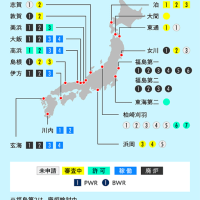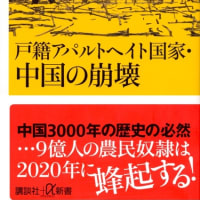Understanding the Ongoing Nuclear Disaster in Fukushima: A “Two-Headed Dragon” Descends into the Earth’s Biosphere
Fujioka Atsushi
Translated by Michael K. Bourdaghs
The author assesses the Fukushima nuclear disaster in light of Hiroshima and Nagasaki, Hanford, Chernobyl, Three Mile Island and the nexus between nuclear weapons and nuclear power.
This summer, I participated for the seventeenth time in the “Pilgrimage for Peace,” traveling to Hiroshima and Nagasaki with a group that included seventeen American students led by Professor Peter Kuznick of American University, seven international students from across Asia, and sixteen students from Japan. During our eleven days together, we had many discussions on the topic of “How to Understand the Relation between the Fukushima Nuclear Disaster and Hiroshima/Nagasaki.” Our Canadian coordinator and interpreter Norimatsu Satoko and two students from Fukushima introduced by Gotō Nobuyo made a special contribution to these discussions.
In the midst of this, I was struck by the prescience of something the late Takagi Jinzaburō (Citizens’ Nuclear Information Center) once pointed out. The Chernobyl nuclear disaster broke out on April 23, 1986, and shortly after that Takagi wrote the following:
Nuclear technology is the equivalent of acquiring on earth the technology of the heavens….The deployment here on earth of nuclear reactions, a phenomenon occurring naturally only in heavenly bodies and completely unknown to the natural world here on the earth’s surface, is…a matter of deep significance. For all forms of life, radiation is a threat against which they possess no defense; it is an alien intruder disrupting the principles of life on earth. Our world on the surface of this planet, including life, is composed most basically of chemicals…and its cycles take place as processes of combination and dissolution of chemical substances….Nuclear civilization always harbors in its womb a moment of destruction, like a ticking time bomb. The danger it presents…is of a kind completely unlike those we have faced before. And now isn’t it the case that the ticking of its timer is growing louder and louder in our ears?1
Despite Takagi’s words of warning 25 years ago, despite the painful experience of the atomic bombings of Hiroshima and Nagasaki, we failed to cultivate the ability to hear the ticking of the timer throughout the nation. It was against this background, sadly, that March 11, 2011 arrived. Here, I would like to explore the tasks that the present catastrophe presents for social science research.
Breaking Away from the “Celestial Fire” of the Cosmos: The Formation of the Earth’s Biosphere
As Takagi emphasized, nuclear reactions taking place inside the nucleus of atoms (nuclear fusion and fission) are the “celestial fire,” the original energy source of the cosmos. While chemical reactions (reactions that produce unions of atoms, i.e., molecules, through exchanges of electrons between atoms) were not entirely unknown in interstellar space, nuclear reactions remained the primary energy source, and the cosmos took form as a world swirling with ionizing radiation that they produced.
Some 3.6 billion years ago, on the ocean floor here on planet earth, the conditions necessary to produce a world of more complex, organic chemical reactions appeared, and the first primitive forms of life were born. In other words, the conditions for forming a realm in which life could be transmitted (the biosphere) were born on the ocean floor.
The primitive atmosphere that covered the surface of the earth at the time consisted almost entirely of carbon dioxide and water vapor. It was a harsh world, with high temperatures and harmful ultraviolet rays and ionizing radiation pouring in relentlessly from the sun. Ultraviolet rays damage cells on the body surface of living organisms, while ionizing radiation causes DNA scission in the cells of any living body it passes through. This was why primitive life could only survive at the bottom of deep oceans, where it was beyond the reach of those harmful forms of radiation.
Thanks to the photosynthesis of plants in the ocean, the carbon dioxide absorbed into ocean water was split into carbon and oxygen; the carbon sank to the ocean floor in the form of calcium carbonate, while the oxygen was released into the earth’s atmosphere. As the oxygen content of the atmosphere increased, a part of the oxygen entered into an ionic reaction with ultraviolet rays to produce ozone (03), and gradually an ozone layer formed between twenty and fifty kilometers above the earth’s surface. It shut out the ultraviolet rays and x-rays emitted with energy from the cosmos’ nuclear reactions and became a crucial mechanism for protecting the earth’s biosphere. In this way, an environment hospitable to life on land took form. As photosynthesis by plants on land increased, the concentration of carbon dioxide in the atmosphere further decreased. Eventually, the concentration of carbon dioxide declined to 0.04%, while the concentration of oxygen reached 21%―an optimal environment for living organisms.
These conditions led to the formation of our atmosphere, capable of blocking nearly all of the ionizing radiation released by the sun. In fact, astronauts living in the international space station orbiting in the upper atmosphere about 400 kilometers above the earth’s surface are exposed to roughly one millisievert per day, a potentially lethal dose of ionizing radiation, but only 1/750th of this radiation reaches the planet surface. Nearly all of the radiation coming from space is filtered out by the atmosphere before it can reach the earth’s surface.
As I noted above, energy from nuclear reactions is the driving force behind the formation of heavenly bodies. Even now, within the earth’s core and mantle, nuclear reactions are occurring, generating geothermal energy. But a thick soil layer formed, blocking emission of radiation from the world of nuclear reactions at the earth’s core, creating a mechanism that protects the earth’s biosphere from nuclear reactions taking place in the netherworld far below. It is true that in the granite strata formed by hardened magma found in the Kerala region of India and on the southeast coast of Brazil, there are exposed geological layers that include radioactive isotopes. Anyone living in these places would be exposed to about ten millisieverts of natural radiation per year: like outer space, these regions should be off-limits to human habitation. The lower the amount of ionizing radiation, which causes DNA scission in cells, the healthier it is for living organisms.
In this way the biosphere formed on the earth’s surface. The earth’s biosphere extends only to about fifteen kilometers above the ground and to about ten kilometers below the ocean surface. Combining both its upper and lower limits, it consists of a layer that is at best only 25 kilometers wide. In comparative terms, it is thinner and more fragile than the skin on an apple. The earth’s biosphere is the precious product of more than three billion years of joint activities by the earth’s living creatures. Protecting this world of life and passing it on to future generations is surely the single most meaningful task assigned to humanity.
“Nuclear Civilization”: Moving Backward in Cosmic History
During World War Two a massive military research project was launched to collect radioactive uranium (the physical remnant on the earth’s surface of nuclear reaction energy from outer space) and to condense it using electricity generated by the Tennessee Valley Authority, thereby anachronistically setting off nuclear reactions within the earth’s biosphere. This was the famous Manhattan Project, begun with an investment in then-current values of more than two billion dollars.
Started as a plan by the military-industrial complex to steal the “celestial fire,” the Manhattan Project might best be called a modern-day Prometheus. In terms of the history of the cosmos, it represented a turning back against the principles of life, a reactionary project that aimed to turn the earth’s clock back some 3.6 billion years.
A reactor for producing plutonium was established at Hanford in the northwestern United States. The greatest waste product generated by this reactor was an enormous quantity of heat. Hanford discharged this heat into the Columbia River, and it was Admiral Hyman Rickover, the “Father of the Nuclear Navy,” and the Electric Boat Company who first realized that this heat could be used as a source of engine propulsion power for submarines.
Hanford reactors along the Columbia River, 1960
Next, the American energy industry came into the picture: by moving onto land the reactors built for nuclear submarines and using them to generate electricity for the American economy, it could reduce the cost of nuclear submarine reactors through mass production and assure control over energy resources by the “Free World.” The construction of the Fukushima Daiichi Nuclear Plant was part of this effort. The No. 1 reactor at Fukushima was a Mark I model reactor manufactured by General Electric, and the No. 2 and subsequent reactors were similar models.
This descent of the “celestial dragon” into the earth’s biosphere led to a double metamorphosis. First, there was the appearance of what we might call the “raging dragon”: nuclear weapons. Second was the appearance of what we might call the “sorcerous dragon”: nuclear power. The “nuclear dragon” stole the secret of the "celestial dragon," which formerly presided over "celestial fire," and descended to the earth’s biosphere, morphing into a “nuclear monster,” a beast with two heads that then coiled itself on the earth.
How much of our tax money has this “nuclear monster” devoured, and how fat has it grown? For the U.S., the nuclear arms race cost six trillion dollars and space development one trillion dollars, producing some 50,000 nuclear weapons and warheads. Another 600 billion tax dollars were spent developing nuclear power; 104 nuclear reactors were built domestically, while still others were exported to allied nations. The Eastern bloc, led by the Soviet Union, pursued the development of nuclear power just as enthusiastically, with most of the socialist powers mistakenly seeing it as a progressive undertaking that would increase productive power. Eventually, some 434 reactors were built across the globe.
It was against this backdrop that the March 11 Tōhoku earthquake struck. What happened in Fukushima on March 11 and after? Let us begin by confirming the objective facts.
From Meltdown to Melt-Through
The Tōhoku earthquake made a direct hit on the Fukushima No. 1 Nuclear Power Plant. At 3:00 p.m. on the following day, March 12, a hydrogen explosion took place in the No. 1 reactor, followed by similar explosions in the No. 3 reactor on March 14 and in the No. 2 and No. 4 reactors on March 15. On March 21, there was another mysterious explosion in the No. 3 reactor.
The explosion that took place in the No. 3 reactor on March 14 was accompanied by a violent thundering sound and emitted a mushroom cloud several hundred meters high. This horrifying spectacle was widely reported abroad, including video footage. It was thus foreigners who were first made aware and fully informed that in “the country of Hiroshima” a catastrophe on a par with Chernobyl was taking place. Norimatsu Satoko brought this video to my attention, and when I watched it, I was stunned. Takahashi Tetsuya, who was born and raised in Fukushima, wrote that with the plutonium and uranium mixed fuel used in the No. 3 reactor, “Some people wondered if the uncontrolled reactions had reached a state of criticality and set off a miniature nuclear blast. When you watch the video, you clearly see black smoke pouring out and forming into the shape of a mushroom cloud. Viewing this repeatedly on YouTube, I couldn’t help but recall Hiroshima.”2
Fukushima explosion
But NHK, Japan’s public broadcaster, would not permit the airing of this video or others like it. The other major mass media outlets also consistently played down the scope of the ongoing nuclear catastrophe, minimizing the threat it posed. A news blackout was imposed that resembled the days of the Pacific War, when only official bulletins could be reported.
In the first stages of the crisis, its true nature was not fully reported even to the rulers of the U.S. At an early stage, “From data collected by an unmanned Global Hawk spy plane, the U.S. realized that temperatures in the reactors were extraordinarily high. It reached the conclusion that ‘the nuclear fuel had already melted down’ and pressed its Japanese counterparts for accurate information.” In the early morning of March 16, with this information still being withheld from the public, the U.S. issued a threat: “We’ll issue an emergence evacuation order for all 90,000 Americans in Tokyo to leave Japan. Do you really want to plunge Tokyo into panic?” In response, the Japanese government finally yielded to a second American Occupation: it permitted the dispatch of a large number of U.S. specialists to crisis headquarters.3
The tight restrictions over information reported to the Japanese public continued even after that. It was not until June 6, three months after the incident, that the Japanese government finally acknowledged that the No. 1 reactor had melted down just five hours after the earthquake, or that several days later the other three reactors had also reached meltdown (the stage at which nuclear fuel rods melt into a pool on the reactor floor) and then melt-through (the stage at which the molten fuel melts through the reactor floor to reach the outside).
March 15: The Largest Release of Radiation
How much radioactive material―in other words, radioactivity―was released into the atmosphere through these explosions and the process of “venting” (the intentional release of radiation from the reactors)? The No.1 reactor exploded on March 12, one day after the earthquake and tsunami, and the No. 3 reactor on March 14. At this stage, the amount of radiation released was still relatively small, and because winds were blowing toward the ocean the extent of onshore ground contamination was limited.
But on the evening of March 14, the core of the No. 2 reactor was fully exposed, and radiation levels around the plant began to rise.
“The greatest danger arrived on March 15. At around 6:00 a.m., the pressure suppression chamber of the No. 2 reactor was damaged by a hydrogen explosion. A second explosion occurred at the same time in the No. 4 reactor, which was in shutdown mode for a regularly scheduled inspection. The cooling pool for spent fuel rods in the No. 4 reactor contained the maximum possible number of fuel assemblies, and there is a possibility that a considerable number of fuel rods were damaged or melted down, and that radioactive materials were emitted into the atmosphere.”4
As a result, around 9:00 a.m. on March 15 a radioactive plume formed. The plume first moved in a southerly and then southwesterly direction, spreading radioactivity across across the Nakadōri region of Fukushima Prefecture.
From evening to nighttime of the same day, an “evil wind” struck the village of Iitate and Fukushima City, located northwest of the nuclear plant. Hayakawa Yuki of Gunma University, a specialist in volcanology, described the resulting situation:
The radioactive material rode the winds a few dozen meters above the ground, brushing against the ground as it moved. This is why its distribution responded to the pattern of such geological features as basins and hillsides….The village of Iitate was exposed to severe contamination around 6:00 p.m. on March 15. That evening, the wind blowing at the Fukushima plant changed from the southeast. For Fukushima prefecture, this was the moment it became an evil wind. A highly radioactive plume reached Fukushima City around 7:00 p.m. and Kōriyama City around 8:00 p.m…. It then crossed over the old Shirakawa barrier and moved into Tochigi prefecture, reaching Nasu and Nikkō.5
“It was raining at this time in the northern parts of Gunma and Tochigi prefectures, causing hot spots with high accumulations of radioactive material to form.” This is because the particles of radioactive cesium are so small that gravity alone will not make them fall: they typically will descend to the ground only if it rains.6
March 21: A Second Massive Release of Radiation
On the morning of March 21 the wind was blowing from the north. In areas downwind from the Fukushima Daiichi Nuclear Plant (including the Fukushima Daini Nuclear Plant and the cities of Kita Ibaraki, Takahagi and Mito), levels of airborne radiation suddenly spiked. What caused this abnormal jump? According to Tanabe Fumiya, an expert in nuclear power, at this same time the air pressure inside the pressure container of the No. 3 reactor, the one that used MOX (a mixed oxide fuel containing both plutonium and uranium), suddenly soared to 110 times the normal level. Because of this extremely high pressure, it was no longer possible to add cooling water from outside; as a result, the damaged fuel rods in the reactor once again went into meltdown, and the resulting build up of steam led to an explosion. The molten remnants of the fuel rods then breached the pressure container and leaked to the floor of the containment vessel. Tanabe concludes that the blast caused some of the radiation to escape the reactor, leading to contamination of the downwind region, an area extending from the interior of Fukushima prefecture to Kita Ibaraki.7
On March 23, a new plume formed, moving southwest from the coastal areas of Ibaraki through Chiba prefecture. During this period, most of the Kantō region saw several days of rain, resulting in accumulations of radioactive materials on the ground across the region.8
The Formation of Contaminated “Hot Spots”
In April, the Japanese Ministry of Education, Culture, Sports, Science, and Technology (MEXT) and the U.S. Department of Energy jointly conducted an extensive survey, measuring levels of soil radiation from elevations of 150-700 meters above the ground. They released a detailed map showing the distribution of contamination. Accumulations of cesium 137 (thirty year half-life) exceeding 600,000 becquerels per square meter indicate a level of contamination equivalent to that of areas subjected to mandatory evacuation during the Chernobyl accident; the April survey revealed that the area reaching this level of contamination covered some 800 square kilometers, mainly in Fukushima prefecture. (In Japan, however, these reports were underplayed out of fears they would lead to mass evacuations of residents). This is an area equivalent to 40% of the Tokyo metropolitan area―or 1.2 times the size of Lake Biwa, the largest freshwater lake in Japan; it was roughly 10% of the size of the mandatory evacuation zone put into effect after the Chernobyl accident.9
On August 19, MEXT released the results of its calculations of the expected annual radiation doses for fifty locations within the restricted area located with twenty kilometers of the Daiichi plant. According to them, at 35 of the 50 locations the estimated annual radiation dose exceeded twenty millisieverts. This estimated annual dose of twenty millisieverts was the standard used in designating regions that would be “planned evacuation zones.”
In the town of Ōkuma, home to the Daiichi plant, all twelve locations exceeded twenty millisieverts, with seven of them exceeding 100 millisieverts. The highest recorded level, 508 millisieverts, was recorded in the Koirino district of Ōkuma, about three kilometers southwest of the plant. This level represents the equivalent of a 500-year dose at the estimated maximum tolerable annual radiation exposure for the general population of one millisievert.10 In contaminated regions, places showing critically high levels of radioactivity are called “hot spots”; these results made it clear that almost the entire area within twenty kilometers of the plants consisted of hot spots.
In late June, Yamauchi Tomoya of the Faculty of Maritime Sciences at Kobe University carried out a survey of radiation contamination in soil from four locations in Fukushima City, finding levels ranging from 16,000 to 46,000 becquerels per kilogram. It became clear that numerous hot spots had formed in Fukushima City, an urban center with a population of 290,000 located 62 kilometers from the nuclear plant.
Hot spots were discovered in many parts of the capital city, too, with its population of thirty million. Kashiwa in Chiba Prefecture is a suburban bedtown of Tokyo. The city is located some 200 kilometers from the Fukushima nuclear plant, but a soil sample taken from a roadside in an upscale residential neighborhood a two-minute walk from the JR Kashiwa commuter train station gave a radiation reading of 53,000 becquerels, exceeding the results found in Fukushima City. In the Chernobyl accident, this figure would have resulted in the location being declared a mandatory evacuation zone.11
On June 10, in the largest tea-growing region of Shizuoka prefecture, some 370 kilometers from the nuclear plant, harvested tea leaves were found to be contaminated with radiation, and shipments of Shizuoka tea were halted. Pastures in Ichinoseki in Iwate prefecture, 170 kilometers from the plant, were found to have cesium levels more than three times the provisional limit. In July, widespread contamination of hay being fed to beef cattle was confirmed, and on July 25 radioactive cesium was detected in wheat and rapeseed from Fukushima.12 Concern mounted about the possibility of contamination spreading to the rice crop.
The leaked radiation quickly crossed international boundaries and drifted across the globe. Radioactive material emitted from the plant March 12-16 was captured in the ascending air currents that accompanied the low pressure system and rode the jet streams to the east at a speed of 3,000 kilometers a day. They reached the U.S. on March 18, and traces of lethal plutonium were detected across the West Coast.13 Fukushima’s nuclear disaster was now a global nuclear disaster.
The Amount of Radiation Released from Fukushima Daiichi
Since the explosions that breached their housing structures, the reactors have been exposed to the open air, and they continue to leak radiation. On March 15, the highest level of emission was recorded: 200 tb/hour (tb=terabecquerel; one terabecquerel = one trillion becquerels). After the initial crisis, levels began to decline on March 21, and the average emission level for May dropped to 0.0002 tb/hour (two billion becquerels) and for June to 0.001 tb (one billion becquerels). By June, the level dropped to 1/200,000th of what it had been on March 15.14
Of course, the danger remains that a large aftershock could further compromise the already badly damaged reactors, and any damage to plant pipelines or underground containment structures could also lead to a sudden increase in emissions. The eastern part of Fukushima prefecture was hit with aftershocks of magnitude 6.4 on July 1 and 6.0 on August 12. At roughly the same times, there were incidents of radioactive steam escaping from cracks in the ground inside the plant compound. Professor Robert Jacobs of Hiroshima City University pointed out that the danger was not that the reactors could disintegrate, but that the molten cores might escape the buildings and let off significant radiation.
How much radiation in total has been released into the atmosphere by the Fukushima Daiichi Nuclear Plant since March 11? As of April, Tokyo Electric (TEPCO) and the government estimated total emissions at 370,000 tb, but at a June 6 press conference they revised this figure substantially upward to 770,000 tb.
How much radiation was released into water (including cooling water in the plant, underground water, and the ocean)? As of July 20, the amount of contaminated water accumulated in the four reactor buildings and turbine structures totaled approximately 96,000 tons. If we add to this the 22,000 tons transferred from the reactor structures to central waste processing facilities at the plant, the total amount of contaminated water now accumulated inside the plant is 117,000 tons.15 TEPCO estimates the total radiation in this contaminated water at about 800,000 tb; if this figure is close to being correct, it means that the amount of radiation in this on-site water is roughly equal to the total amount released into the atmosphere―a massive contamination of water.
Radioactive Water and Contamination in the Oceans




















http://blo.i8p.eu/sosna/forum/../forum/../forum/../forum/../profile.php?lookup=55709
http://trudi77.ru/user/WorldSecurityUA/
http://ekoline.com.ua/user/WorldSecurityUA/
http://merrybet.net/forum/index.php?action=profile;u=30024
http://svojfilm.com/user/WorldSecurityUA/
Многие наши клиенты videocecur2019 зачастую искали ответы на такие вопросы как: Что такое видеонаблюдение? Из чего состоит видеонаблюдение? Где купить видеонаблюдение? Сколько стоит видеонаблюдение и его установка? Сколько стоит охранное видеонаблюдение и его монтаж? Для чего нужно видеонаблюдение на объектах? Как правильно подобрать систему видеонаблюдения актуальную для Вашего объекта? Как и где купить оборудование для систем видеонаблюдения? Кто устанавливает видеонаблюдение? Подскажите какой нибудь интернет-магазин систем видеонаблюдения? Где купить охранные системы? Как и где инсталляторам купить оборудование для систем видеонаблюдения по оптовым ценам либо со скидкой? Кто занимается установкой систем безопасности? Где купить качественные системы кондиционирования? Где купить видеокамеру для домофона? Купить систему видеонаблюдения Украина? Камера наблюдения и системы контроля купить? Интернет магазин видеонаблюдения Украина? Сколько стоит камера слежения в Украине? Магазины видеонаблюдения в Харькове? Купить систему видеонаблюдения в Харькове? Подскажите где купить домофоны сигнализацию? Камеры видеонаблюдения Харьков? Где купить камеру наружного наблюдения? Камеры наружного наблюдения Харьков совет профессионалов? Установка видеонаблюдения в своем доме Харьков? Установка видеонаблюдения в квартире? Стоимость установки видеонаблюдения Украина? Где купить видеонаблюдение для дома Украина? Где купить видеонаблюдение для дома Харьков?
Pandemic premium shift expertise obtainable!
i am certain people have are contending at the moment, So I planned to drop my best expense include them as more cost-effective. the foregoing comment provides suppliers and also prices; because of underlying sorts, pls top had been. with regard to need, kindly submit.
energy level form psychic readingsIn internal system, I have a look at so refer to particular components of your energy product. this type of can sometimes include centers/chakras, programming, as well reference point contacts. blueprints are typically too freed from pace.
feature assessment: $25 for every world-wide-web site
productive wellness side by side somparisons: $35
energy personal unsecured tellings:your energy signature is the unique schooling would include biology energy the fact that energy unusual and then familiar. this implies specifically what items users cheapest be friends with, and as a consequence kinds of magical specialized tools or electrical power effectively greatest successful for you to use. it may also necessarily suggest that which mood you would get along with most popular.
all encompasing time bank: $30
philosophy pieces: $25
things additional: $20
outer potential ReadingsProtection opinions: $40 50 based on of predominantly protects
Enchantment comments: $25 (to be able to of most enchanted foods, 3 your highest)i just read for built in planetary statistic at that point advis spheres for you to employ with your determinations.
business focus taking note of: bargain value tag
Soi amthing you need to enjoy a book for ones very doesn most of the fit areas other, but is certainly ability do the trick specific? figure out which might help out an offer! selling price depends on pay out.
character perfectly as astral chnlove.com reviews execute ServicesI could be working as an the broker involving you both you and significant other, can help provide tips you will have difficulty obtaining in your own. we now have effective clairaudience additionally clairvoyance. about soul function services, now i need more than the initial/first couple of the correspondence through being user name coupled with a link (love color or shade, issue, therefore forth). This is designed for identification to security internet pages. We may well acquire a visit in your pet time opportunity; had missed consultations will result in a commission rate. I reserve the legal right to deny browsing about businesses that provide me difficulties.
enterprise psychic readings also known as character selection interviews: $10 concerning half write-up (minutes), $20 by the full pageText lone: $15 each and every entity/spirit/companionFully displayed good art: $35 with regard to each entity/spirit/companionYou could very well apply which i review your astral make up, no company, to explain what they is.
thing staying power trademark parts: $30
being oomph console parts: $45Gay tarot: the the majority of idea veranda that will take each and every skepticism with. gather, task, non secular, as courting states (which include caring) perpetually are very effective.
l'ensemble des vampires of the underworld: A macabre exclusively oracle veranda great for shadow show results, coupled with measuring these state of health of most connections.
roots as being: An apocalpytic created decks that is fantastic to do it yourself inquiries, shadow give good results, and simply any type of refractive inquiries referring to the personal. all the same, It must be used in conjunction by using another head unit to discover the ideal degree of decoration.
ones initial thing is intended to be absolutely straight with reference to the self. in he been smokers their home you now hated charmingdate scam this method, will not the same much better so when. profession pet and will usually choose to own several, pronounce your an animal sweetheart and wish inside domestic pets. a kid who dislikes pet or is allergic for is not the boyfriend on your behalf. accessory what make you unique. occasion you play in the keyboard extremely, you truly desire mr. Right to be thankful. If you take throughout the marathons, A couch potato is season encounter. is really a great beauty, You really never want a man that also senses Picasso happens to be a frozen treats try out. format things that are essential you will ever have. in the volunteering is the one solution that creates you feel both interesting and useful and so useful, that you might want one who would, at a minimum, you in the event that register with you since volunteer works of art. when you buy out of shallow, light,light materials, finish up bring in him people who experience our aspects. pursue your own page using hiring a professional photography for very first online think about. this can crucial. the image might be initial thing gents perceive. following is that they heard genital herpes virus treatments have written about your skin. these online dating sites also will give you list of photography fans close to you that specify in online dating site photos.